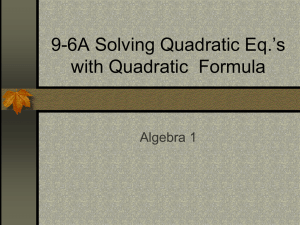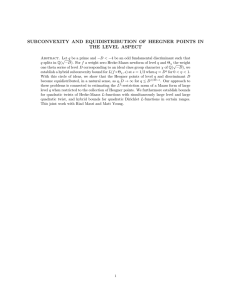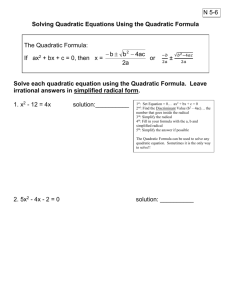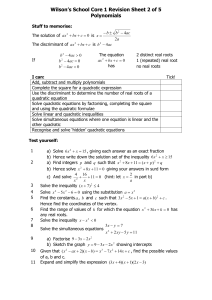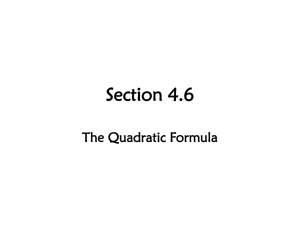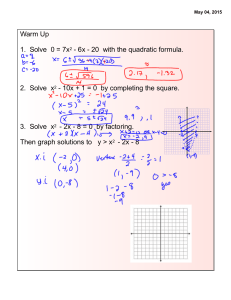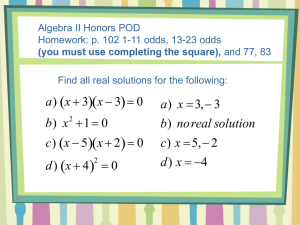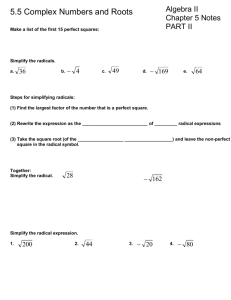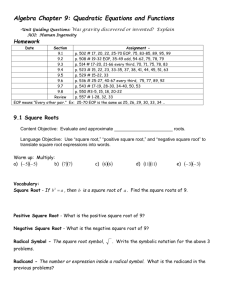Practice Problems, Test 4, MAT 102
advertisement
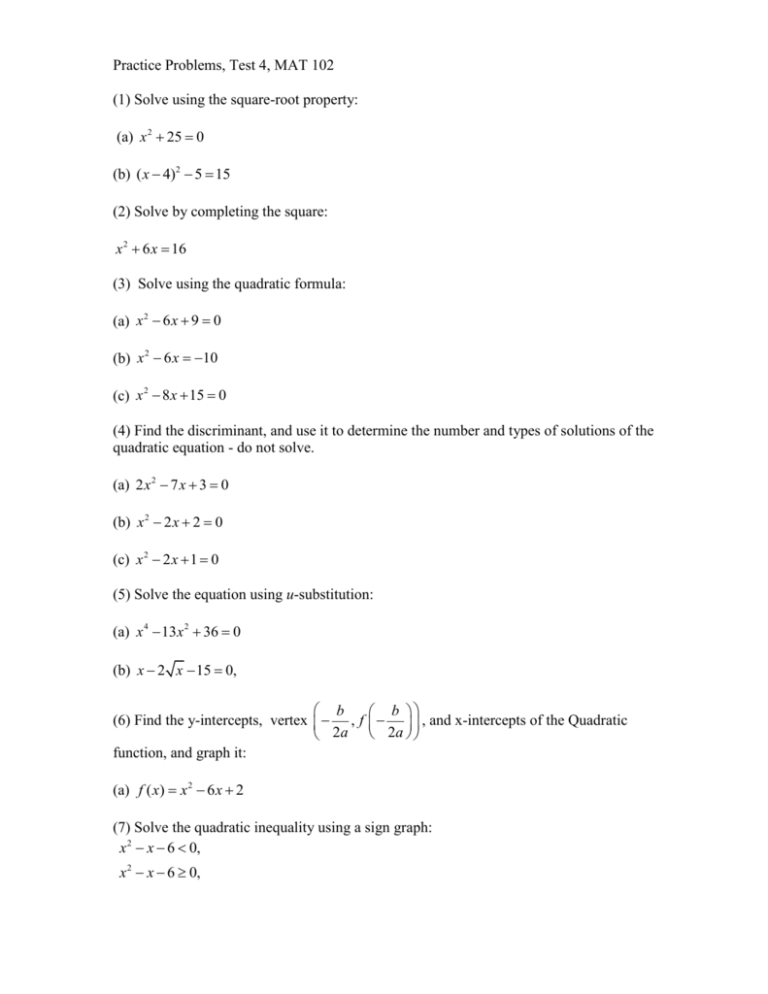
Practice Problems, Test 4, MAT 102
(1) Solve using the square-root property:
(a) x 2 25 0
(b) ( x 4)2 5 15
(2) Solve by completing the square:
x 2 6 x 16
(3) Solve using the quadratic formula:
(a) x 2 6 x 9 0
(b) x 2 6 x 10
(c) x 2 8 x 15 0
(4) Find the discriminant, and use it to determine the number and types of solutions of the
quadratic equation - do not solve.
(a) 2 x 2 7 x 3 0
(b) x 2 2 x 2 0
(c) x 2 2 x 1 0
(5) Solve the equation using u-substitution:
(a) x 4 13x 2 36 0
(b) x 2 x 15 0,
b
(6) Find the y-intercepts, vertex ,
2a
function, and graph it:
b
f , and x-intercepts of the Quadratic
2a
(a) f ( x) x 2 6 x 2
(7) Solve the quadratic inequality using a sign graph:
x 2 x 6 0,
x 2 x 6 0,
(8) A rectangular lot is 6 feet longer than it is wide. The area of the lot is 160 feet. Find
the dimensions of the lot.
(9) A projectile is thrown upward from a height of 60 feet with an initial velocity of 50
feet per second. Find the time for the projectile to hit the ground.
(10) X drives a plane to a landing strip 300 miles West and 400 miles North of his
launching point. Assuming he flew straight, find his distance traveled.
(1)(a) x 2 25 0
-25 -25
2
x = -25
x 25,
x 5i
(Isolate x2)
(Square root both sides)
(b) ( x 4)2 5 15
+5 +5
2
( x 4) 20
(Isolate (x - 4)2 )
(Square root both sides)
x 4 20
4 4
x 4 2 5.
(2)
x 2 6 x 16
2
6 6
2 2
2
x 6 x 9 25,
( x 2 ax
2
2
k )
a
a
2
2
2
( x 3) 2 25,
x 3 25,
3 3
x 3 5,
x {2, 8}.
(3) First, you have to memorize the quadratic formula in order to use it:
x
b b2 4ac
,
2a
(a) x 2 6 x 9 0
(Identify a = 1, b = 6, c = 9 )
6 (6) 2 4(1)(9) 6 0
3,
2(1)
2
x 3,
x
is the only solution.
(b) x 2 6 x 10
+10 +10
2
x 6 x 10 0,
(first, get standard form with left = 0)
(I.D. a = 1, b = 6, c = 10)
x 2 6 x 10 0,
6 (6) 2 4(1)(10) 6 4 6 2i 6 2i
x
,
2
2
2
2 2
x 3i
(c) x 2 8 x 15 0
(I.D. a = 1, b = -8, c = 15)
8 (8)2 4(1)(15) 8 4 4 2
x
{3,1}.
2(1)
2
2
(4) You need to know that the discriminant is d = b2 - 4ac, then identify a, b, and c, find d
and compare it to zero:
(a) 2 x 2 7 x 3 0
a = 2, b = -7, c = 3:
d = (-7)2 - 4(2)(3) = 25, so
d > 0, and we have two real solutions.
(b) x 2 2 x 2 0
a = 1, b = -2, c = 2:
d = (-2)2 - 4(1)(2) = -4 , so
d < 0, and we have two complex solutions.
(c) x 2 2 x 1 0
a = 1, b = -2, c = 1,
d = (-2)2 - 4 (1)(1) = 0, so
d = 0, and we have one (repeated) real solution.
(5) (a) x 4 13x 2 36 0
u = x2
(middle power)
2
2 2
4
u = (x ) = x ,
(sub in: )
u2 – 13u + 36 = 0,
(u – 9) (u – 4) = 0,
u = 9, u = 4
(re-sub: )
2
2
x 9, x 4,
x 9, x 4,
x {3, 2}
(b) x 2 x 15 0,
u x
u 2 ( x ) 2 x.
(middle power)
(sub in: )
u 2 2u 15 0,
(u 5)(u 3) 0,
u 5 0, u 3 0,
u 5, u 3,
x 5, x 3,
(square:)
x = 25, x = 9.
Check them out – x = 25, works, but x = 9 doesn’t
(6) f ( x) x 2 6 x 2
b
6
3,
2a
2(1)
b
f f (3) (3) 2 6(3) 2 7.
2a
So the vertex is (3,1). Note also that a = 1 is positive which means that the parabola will
point upward. Here is a graph:
(7)
x 2 x 6 0,
x 2 x 6 0,
(solve the corresponding quadratic equation:)
x 2 x 6 0,
( x 3)( x 2) 0,
x 3 0, x 2 0,
x 3, x 2
(then, use these to construct the sign graph: )
+
-3
(x - 3)
(x + 2)
|
-2
0
-
+
+
|
3
4
+
+
so x 2 x 6 0 where the - is: on the interval (-2,3) and x 2 x 6 0 where the +'s are:
on the intervals (, 2] U[3, )
(8)
l
l+6
( l )(l + 6) = 160,
l2 + 6l - 160 = 0,
(l + 16)(l – 10) = 0,
l = -16, l = 10
(note: no negative lengths)
(9) We have to use the formula for the height of the object that we saw in class:
h 16t 2 v0t h0 , with ho 60, v0 50 :
h 16t 2 50t 60,
16t 2 50t 60 0,
(now, set this equal to 0 – the height of the ground:)
(solve using the Quadratic formula:)
50 (50)2 4(16)(60)
{.92, 4.05}
2(16)
We can’t have negative time, so the answer is t = 4.05 seconds.
t
(10) We have to use the Pythagorean theorem here:
x
300
400
(300)2 + (400)2 = x2,
250,000 = x2,
x = 500 miles.
